|
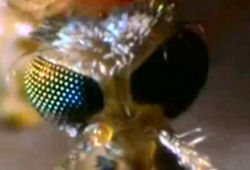 Those
people with a known allergy to the stings should carry an
emergency syringe with 0.1% adrenaline and know how to use
it. Those
people with a known allergy to the stings should carry an
emergency syringe with 0.1% adrenaline and know how to use
it.
Biting
insects themselves, aren't generally dangerous because allergic
reactions are rare. They do however, spread diseases like
Malaria, Yellow Fever, Lyme disease, Typhus, and Encephalitis,
but for most of us their bites just cause terrible itching.
Protection Against Insect Bites
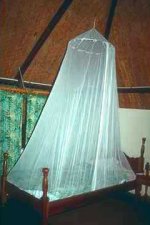 The
occurrence of mosquito and other insect bites can be minimised
by wearing long-sleeved shirts, long pants, and hats to reduce
exposed skin. Repellents applied to clothing, shoes, tents,
mosquito nets, and other gear will enhance protection. The
occurrence of mosquito and other insect bites can be minimised
by wearing long-sleeved shirts, long pants, and hats to reduce
exposed skin. Repellents applied to clothing, shoes, tents,
mosquito nets, and other gear will enhance protection.
Bednets provide protection and comfort when accommodations
are not adequately screened or air-conditioned. Bednets should
be tucked under mattresses and can be sprayed with repellent.
Aerosol insecticides and mosquito coils may help to clear
rooms of mosquitos; however, some coils contain DDT and should
be used with caution.
Tucking
shirts into pants and pants into socks will increase protection.
Boots also decrease the risk of bites. During outdoor activities
and at the end of the day, travellers should inspect themselves
and their clothing for ticks. Prompt removal of ticks may
prevent infection. These tips are also helpful in answering
the question to how
to get rid of bed bugs that are devouring you at night.
Repellents
containing DEET (N, N-diethylmeta-toluamide) are commonly
available and effective against mosquitos, ticks, and other
arthropods when applied to skin or clothing. Repellents with
DEET concentrations of about 30% are quite effective and should
last for about four hours. The possibility of adverse reactions
to repellents can be decreased by taking the following precautions:
- Apply
repellents sparingly only to exposed skin or clothing
-
 Avoid
high concentrations of DEET Avoid
high concentrations of DEET
-
Do
not inhale, ingest, or get into the eye
-
Never
use on wounds or irritated skin
-
Wash
repellent-treated skin after coming indoors
-
 Pregnant
and nursing women should minimise use Pregnant
and nursing women should minimise use
-
Avoid
applying to children's hands that are likely to
have contact with eyes or mouth
-
To
view a video about the need for protection from
mosquito bites, click on the image right:-
|
Permethrin
is also a highly effective repellent and insecticide for
use on clothing, shoes, bednets, and camping gear. Permethrin-treated
clothing repels and kills ticks, mosquitos, and other arthropods
and retains this effect after repeated laundering.
 Protect yourself and your kids from mosquito bites
as well as ticks and other harmful insects, with Permethrin
Impegnated Insect Repellent Clothing. Click the graphic to
browse the web site:-
Protect yourself and your kids from mosquito bites
as well as ticks and other harmful insects, with Permethrin
Impegnated Insect Repellent Clothing. Click the graphic to
browse the web site:-
Treatment
of Bites
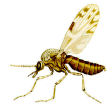 Itching
is the main symptom to control with insect bites. Topical
antihistamines and anaesthetics are for quick temporary relief;
hydrocortisone cream has slower onset, but longer effect. Itching
is the main symptom to control with insect bites. Topical
antihistamines and anaesthetics are for quick temporary relief;
hydrocortisone cream has slower onset, but longer effect.
-
Ibuprofen
Gel. For pain and swelling from insect stings, is an excellent
anti-inflammatory with quick onset.
-
Hydrocortisone
cream 1% This preparation improves both itching and swelling/redness.
It actually has anti-inflammatory effects, not just symptomatic
relief like the topical anaesthetics. However, it does
take longer for full effect than topical anaesthetics.
-
Xylocaine
Gel 2% For immediate relief from surface itching and pain.
Any systemic
reaction should be seen by a doctor immediately. This includes
hives wherever they may occur, swelling in the face, shortness
of breath or wheezing, difficulty swallowing, and light-headedness
or fainting. These usually occur within minutes to an hour
after the sting.
Local
reactions generally don't require professional care. However,
if your local reaction causes enough swelling or pain to distract
you from your normal activities or keep you awake despite
basic treatment, you should see a doctor. If the redness/swelling
is worsening after 24 hours, see your doctor.
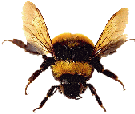 Treatment
of Stings Treatment
of Stings
First, the stinger must be removed. Pain, swelling,
and itching are the main complaints. Home remedies include
baking soda or meat tenderiser compresses to "draw out" or
destroy protein-based venom. Scientific data is lacking with
these techniques, but they do make logical sense. See the
table below for medications which can help.
|
Symptoms
|
Medication
|
|
Pain,
swelling
|
Anti-inflammatory
drugs
|
|
Itching
|
Topical
antihistamines,
anaesthetics/analgesics;
topical hydrocortisone
|
|
Prevention
of infection
|
Topical
anti-bacterials
|
Sting
Removal:
Place the edge of a dull table knife firmly against your skin
next to the embedded stinger. Applying constant firm pressure,
scrape the knife across your skin surface and the stinger.
This removes the stinger without injecting more venom, which
is what happens when you remove the stinger with tweezers
or your fingers.
 Bees
and Wasps Bees
and Wasps
Bee, wasp, and hornet stings cause immediate pain and a red,
swollen, sometimes itchy area about ½ inch (about 1
centimeter) across. In some people, the area swells to a diameter
of 2 inches (5 centimeters) or more over the next 2 or 3 days.
This swelling is sometimes mistaken for infection, which is
unusual after bee stings. Allergic reactions may cause rash,
itching all over, wheezing, trouble breathing, and shock.
Treatment usually involves:
-
Removal
of stinger (if present)
-
Skin
treatments and medications by mouth to reduce pain and
swelling
-
Epinephrine
injection for allergic reactions
-
Sometimes
desensitization to prevent allergic reactions
 A
bee may leave its stinger in the skin. The stinger should
be removed as quickly as possible by scraping with a thin
dull edge (for example, the edge of a credit card or a thin
table knife). Wasps, yellow jackets, hornets, and ants do
not leave stingers in the skin. A
bee may leave its stinger in the skin. The stinger should
be removed as quickly as possible by scraping with a thin
dull edge (for example, the edge of a credit card or a thin
table knife). Wasps, yellow jackets, hornets, and ants do
not leave stingers in the skin.
An ice cube wrapped in plastic and a thin cloth and placed
over the sting reduces the pain, along with a nonsteroidal
anti-inflammatory drug e.g. Ibuprofen and antihistamines taken
by mouth. A cream or ointment containing an antihistamine,
an oral antihistamine, an anesthetic, a corticosteroid, or
a combination of them my be useful.
Severe allergic reactions (anaphylactic reactions) are treated
in the hospital with epinephrine, intravenous fluids, and
other medications.
People who are allergic to stings should always carry a preloaded
syringe of epinephrine (available by prescription), which
helps reverse anaphylactic or allergic reactions. People who
have a history of anaphylactic reactions or a known allergy
to insect bites should wear identification, such as a medical
alert bracelet.
Ant
Bites
 There
are over 12,000 species of ants in the world and all ants
live in groups (colonies that are similar to bees). Some ants
are harmless to humans, while others can bite or sting to
defend themselves. There
are over 12,000 species of ants in the world and all ants
live in groups (colonies that are similar to bees). Some ants
are harmless to humans, while others can bite or sting to
defend themselves.
With the exception of Greenland, Iceland, Antarctica and certain
island nations, ants are found almost everywhere on the planet.
They typically live in decaying plants or mounds of soil and
leaves.
Some of the most common ants that bite and sting include:
Fire ants, Carpenter ants & Bullet ants.
Most ant bites can be treated in the same way as bee or wasp
stings.
The bullet ant’s sting is said to feel like a
gunshot—hence the insect’s common name—and
it is considered to be the most painful of all insect
stings.
Bullet ants are found in the humid lowland rainforests of
Central and South America, ranging from El Salvador and Honduras
to Peru, Bolivia, and Brazil. They are reddish brown or brown
in colour and approximately 1.8 cm–2.5 cm (0.7–1
inch) in length.
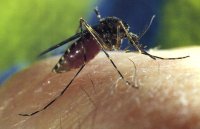 Mosquitoes Mosquitoes
These are the familiar flying insects, (family Culicidae),
numbering about 2,500 species, that are important in public
health because of the bloodsucking habits of the females.
Mosquitoes
are particularly dangerous insects since they are known to
transmit such serious diseases as yellow fever, malaria, filariasis
dengue and Japanese B encephalitis. They bite at any time
of day but mostly in the evening.
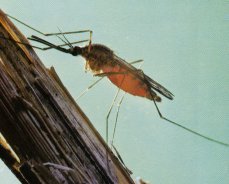 Different
species of mosquitoes show preferences and, in many cases,
narrow restrictions as to host animals. They are apparently
attracted to host animals by moisture, lactic acid, carbon
dioxide, body heat, and movement. Different
species of mosquitoes show preferences and, in many cases,
narrow restrictions as to host animals. They are apparently
attracted to host animals by moisture, lactic acid, carbon
dioxide, body heat, and movement.
The slender,
elongated body of the adult is characterised by its long,
fragile-looking legs and its mouth-parts, which are contained
in an elongated proboscis. The threadlike antennae of the
male are generally bushier than those of the female.
The males,
and sometimes the females, feed on nectar and other plant
juices, but in most species the females require a blood meal
in order to mature their eggs, which are laid on the surface
of water.
The eggs
hatch into aquatic larvae, which feed on algae and organic
debris; a few are predatory and may even feed on other mosquitoes.
The adults mate soon after emerging from their pupal cases.
The duration of the life cycle varies greatly depending on
the species.
| There
are three important mosquito genera: |
|
- The
genus Anopheles the only known carrier of malaria,
also transmits filariasis and encephalitis. Anopheles
mosquitoes are easily recognised in their resting
position, in which the proboscis, head, and body are
held on a straight line to each other but at an angle
to the surface. The life cycle is from 18 days to
several weeks.
|
 |
- The
genus Culex is a carrier of viral encephalitis,
west nile virus and, in tropical and subtropical climates,
filariasis. It holds its body parallel to the resting
surface and its proboscis is bent downward relative
to the surface. The life cycle, usually 10 to 14 days,
may be longer in cold weather.
|
 |
- The
genus Aedes transmits yellow fever, dengue,
and encephalitis. Like Culex, it holds its body parallel
to the surface with the proboscis bent down. The wings
are uniformly coloured. A.aegypti the carrier of yellow
fever and dengue, has white bands on its legs and
spots on its abdomen and thorax. Aedes usually breeds
in floodwater, rain pools, or salt marshes, the eggs
being capable of withstanding long periods of dryness.
The life cycle may be as short as 10 days or as long
as several months.
|
 |
| Some
facts about Mosquitoes |
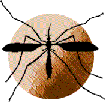 Why
do mosquitoes bite? Only female mosquitoes bite. Female
mosquitoes require a blood meal to acquire the protein
needed to produce eggs. Females lay multiple batches of
eggs during their lifespan, and a new blood meal is needed
to produce each batch. Different mosquito species prefer
different host species; some mosquitoes will seek blood
meals from birds, others from mammals - and some are generalists.
The female inserts her needle-like proboscis - a slender,
tubular, feeding and sucking organ - under the victim's
skin, drawing blood into her abdomen. She will feed until
her abdomen is full, unless discovered and brushed away. Why
do mosquitoes bite? Only female mosquitoes bite. Female
mosquitoes require a blood meal to acquire the protein
needed to produce eggs. Females lay multiple batches of
eggs during their lifespan, and a new blood meal is needed
to produce each batch. Different mosquito species prefer
different host species; some mosquitoes will seek blood
meals from birds, others from mammals - and some are generalists.
The female inserts her needle-like proboscis - a slender,
tubular, feeding and sucking organ - under the victim's
skin, drawing blood into her abdomen. She will feed until
her abdomen is full, unless discovered and brushed away.
Why do mosquitoes seem to bite some people, but not
others? This phenomenon is not completely understood.
Mosquitoes are attracted by the carbon dioxide that we
- and other animals - exhale. They may also be attracted
by various odors - perfume, perspiration, lactic acid,
detergents - that combine in unique ways to make one victim
more attractive than another as a meal. Because dark colors
absorb heat and lighter colors tend to reflect heat, mosquitoes
also tend to be more attracted to victims dressed in darker
clothes. Also, some people react more violently to the
bites than others and only appear to be bitten more often.
Why do mosquitoes bites itch and swell? The itching,
swelling, and burning from a mosquito bite are actually
caused by the body's autoimmune response to the saliva
injected by the mosquito when she feeds. This saliva contains
anti-coagulating agents that prevent the victim's blood
from clotting as it is sucked into the mosquito's abdomen.
A bite may take several days to heal and stop itching;
treat it with Calamine lotion or a topical anti-itch medication.
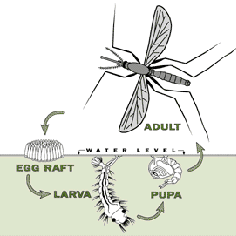 Where
do mosquitoes breed? Mosquitoes breed in wet, swampy
areas, where they lay their eggs. The eggs hatch in the
water, and the young mosquitoes spend their pupal stages
in the water. Mosquitoes lay eggs in both fresh and polluted
water, and seek still waters such as those found in small
puddles, ditches, and ponds. Even a small amount of standing
water - say, in the bottom of a flower pot - will provide
sufficient habitat for mosquito eggs. These eggs usually
hatch about 5 days after they are laid. A key factor in
mosquito prevention is the elimination of standing water
in an area. Where
do mosquitoes breed? Mosquitoes breed in wet, swampy
areas, where they lay their eggs. The eggs hatch in the
water, and the young mosquitoes spend their pupal stages
in the water. Mosquitoes lay eggs in both fresh and polluted
water, and seek still waters such as those found in small
puddles, ditches, and ponds. Even a small amount of standing
water - say, in the bottom of a flower pot - will provide
sufficient habitat for mosquito eggs. These eggs usually
hatch about 5 days after they are laid. A key factor in
mosquito prevention is the elimination of standing water
in an area.
What is the average lifespan of a mosquito? Like
most insects, mosquitoes are a prime food source for birds,
amphibians, and spiders. Between predators and extreme
weather events such as drought and harsh rains, most mosquitoes
live for an average of about two weeks in their adult
form. If they manage to escape predators, females from
some mosquito species live to about two to three months
of age. Those females who enter adult form late in the
season may go into hibernation as cooler weather approaches,
and can emerge the following spring to lay eggs. In many
species, eggs laid before the onset of cold weather can
also survive through a winter, even without water, re-hydrating
in spring rains to go through larval, pupal, and adult
stages.
How many types of mosquitoes are there? According
to the American Mosquito Control Association, there are
more than 2500 species of mosquitoes world-wide.
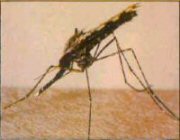
anopheles |
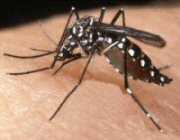
aedes aegypti |
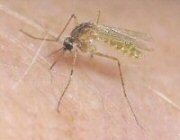
culex |
|
 Sand
Flies Sand
Flies
These include any insect of the family Phlebotomidae
of the order Diptera. The aquatic larvae live in the inter-tidal
zone of coastal beaches, in mud, or in wet organic debris.
The adults are often called biting midges and are only 2 to
3 mm in length making them difficult to see.
Sand flies are found in almost any aquatic or semiaquatic
habitat throughout the world. Many of the blood-sucking species
are pests in beach or mountain habitats. They may also be
vectors of disease-causing viruses, protozoa, and filarial
worms.
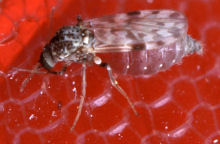 The
bite is not painful but often causes an allergic response
which becomes very itchy. Some people get a red weal 1-2 inches
wide! Avoid scratching the weals; it makes them itch longer
and can lead to infection. The
bite is not painful but often causes an allergic response
which becomes very itchy. Some people get a red weal 1-2 inches
wide! Avoid scratching the weals; it makes them itch longer
and can lead to infection.
Sand flies
are of considerable medical importance: around the Mediterranean
and in southern Asia, Phlebotomus transmits the pappataci
fever virus; and in parts of South America, Africa, and Asia
it carries the protozoan parasites causing kala azar, Oriental
sore, espundia, and bartonellosis.
The name
sand fly is also used for certain species of the black fly
and the biting midge. They are often referred to as No-See-Ums
because you rarely see them.
More Than Just an Irritation:-
Lurking on the beaches of many of our favourite holiday
and diving resorts is a disease that can do more than just
ruin your holiday.
It's a disease that can haunt you for months after you return
home, and even ruin your life. Though it's not as widely known
as malaria, it can be every bit as painful, tenacious, and
dangerous.
 Worse
yet, the source of the infection is nearly invisible - the
ubiquitous no-see-um - the disease it transmits - Leishmaniasis. Worse
yet, the source of the infection is nearly invisible - the
ubiquitous no-see-um - the disease it transmits - Leishmaniasis.
If you've never heard of leishmaniasis, you're hardly alone.
The culprits that spread the disease, commonly referred to
as no-see-ums (because you hardly ever see them), are minute
insects of the genus Phlebotomus often called "sand flies"
and like mosquitoes, the gestating female no-see-ums hungry
for protein go in search of a "blood meal". It is during the
process of feeding that they transmit the protozoan parasites
responsible for the disease.
It is
also possible for a fever and rash to develop after receiving
several no-see-um bites as a reaction to the toxins in the
bites themselves, and multiple no-see-um bites can cause death
from their toxins alone.
 Leishmaniasis
currently affects around 12 million people in 88 countries
(with 2.5 million new infections annually). Leishmaniasis
currently affects around 12 million people in 88 countries
(with 2.5 million new infections annually).
It is considered a dynamic disease whose range is constantly
spreading which is now well entrenched in the Mediterranean,
North Africa, The Middle East, South East Asia, Central America
and the Caribbean.
In its
cutaneous form, leishmaniasis is characterised by a skin sore
or sores that develop weeks or months after transmission.
Sores typically leave scars, and some forms can be severely
disfiguring.
Visceral
leishmaniasis, traditionally known as kala-azar may take months
and even years to develop and is fatal if untreated. Symptoms
include fever, weight loss, cough, diarrhoea, lethargy, enlargement
of the spleen and liver, and anaemia. Both forms require a
biopsy for diagnosis.
Though
leishmaniasis only accounts for a small percentage of tropical
infections, unless the victims consult physicians specialising
in tropical medicine, diagnosis is often inaccurate. The disease
is quite difficult to cure and victims are prone to recurrences.
 For
decades the most effective treatment has been considered to
be sodium stibogluconate, but the three-week intravenous regimen
is relatively toxic, and the parasite is reportedly becoming
antimony-resistant in some areas so there is no guarantee
that it will not recur. Other treatments are available, but
no cure is 100% effective, and there are currently no vaccines
available. For
decades the most effective treatment has been considered to
be sodium stibogluconate, but the three-week intravenous regimen
is relatively toxic, and the parasite is reportedly becoming
antimony-resistant in some areas so there is no guarantee
that it will not recur. Other treatments are available, but
no cure is 100% effective, and there are currently no vaccines
available.
With no
certain cure, prevention is definitely the key. No-see-ums
are usually more of a problem at night and when the wind dies
down on the beach. The first line of defence is to cover yourself
with insect repellents containing DEET. Wear long-sleeved
shirts, long trousers, and socks in the evenings.
While
the odds of bringing home leishmaniasis are probably too small
to allow it to influence travel plans, the consequences of
infection are so unpleasant that it makes good sense to take
aggressive steps to avoid becoming the main course for a hoard
of hungry no-see-ums.
If on
return from an endemic area, you develop persistent sores
that you fear may be indicative of leishmaniasis, ask for
a referral to a tropical medicine specialist.
Tsetse Flies
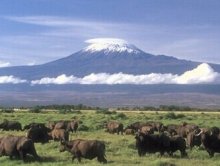 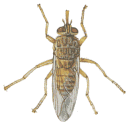
Tsetse flies can be anything from 7 to 15mm long. They are
sturdy flies not unlike houseflies and they have a painful
bite. They spread the disease known as sleeping sickness (Trypanosomiasis)
which is caused by a single celled motile organism. The disease
is serious and sometimes fatal and is difficult to treat.
There is no vaccine available. Sleeping sickness is thought
to be present in 36 countries of sub-Saharan Africa.
Tsetse flies require shade and humidity and tend to occur
along rivers and lake shores in association with game animals.
They are attracted to the scent of animals, movement and bright
colours.
 Fleas Fleas
Adult fleas are about 2mm long, wingless, and have three pairs
of legs. The hind pair of legs is modified for jumping. Fleas
are reddish-brown in colour and vertically flat like a fish,
and can move easily through the hair of a host. They feed
on the blood of their hosts.
Fleas
breed wherever their host sleeps. Flea eggs are small and
white. The larvae of the flea look like small white worms
with dark heads. They live on the floor and feed on organic
debris. They form pupae which can lie dormant until they sense
a suitable host passing by and then they come out to feed.
 The
human flea, (Pulex Irritans), is almost extinct in Europe
but other types of animal flea are much more common and will
bite humans especially when they cannot find their usual animal
host or if they become very numerous. Their bite often leaves
a small, red, irritated area. The
human flea, (Pulex Irritans), is almost extinct in Europe
but other types of animal flea are much more common and will
bite humans especially when they cannot find their usual animal
host or if they become very numerous. Their bite often leaves
a small, red, irritated area.
 Flea
bites tend to occur in groups, along clothing constrictions
and around the ankles. Flea
bites tend to occur in groups, along clothing constrictions
and around the ankles.
They often pass out undigested blood leaving tell tale blood
spots on bed sheets.
Some types of flea, especially rodent fleas, are able to transmit
diseases. Two of the more well known are endemic typhus and
plague. However these diseases are quite rare and confined
to the poorest areas of urban squalor.
Chigoe
fleas
These fleas are endemic to Central America and West Africa.
They live outdoors in dry sandy locations. The female penetrates
the skin around the toes and then swells up with eggs causing
inflammation and ulceration. Gangrene can set in if left untreated.
Avoid going barefoot in areas known to be infested.
 Lice Lice
There are three types of louse that affect humans;
the head louse, the crab louse and the body (clothing) louse.
The head louse lives on the scalp, the crab louse lives in
pubic hair and sometimes arm pits and beards, and the body
louse infests clothing. They all feed by sucking the blood
of their host and they are spread by intimate contact or by
sharing clothes.

The best
evidence of louse infection is the discovery of the tiny egg
cases called nits attached to body hair or clothing.
The only
significant disease spread by lice is typhus which is spread
by body lice and is restricted to the very poorest areas.
Otherwise lice are merely a nuisance because of allergic reactions
and minor skin infections caused by their bites.
Ticks
& Mites
 Travellers
walking through dense undergrowth or exploring caves may find
ticks or mites attached to their skin but they are relatively
easy to remove with a pair of tweezers: grip the tick firmly
under the head end and push down to disengage the "teeth"
then gently pull away. Once the tick has been removed, treat
the bite area with antiseptic. Travellers
walking through dense undergrowth or exploring caves may find
ticks or mites attached to their skin but they are relatively
easy to remove with a pair of tweezers: grip the tick firmly
under the head end and push down to disengage the "teeth"
then gently pull away. Once the tick has been removed, treat
the bite area with antiseptic.
Ticks
are responsible for spreading diseases such as typhus, encephalitis
and lyme disease.
Scabies
is caused by a small mite which burrows into the outer layers
of the skin and cause the characteristic itch which can be
almost unbearable but the mite does not carry any infectious
disease.
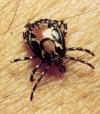 Scabies
is caused by a small mite which burrows into the outer layers
of the skin and cause the characteristic itch which can be
almost unbearable but the mite does not carry any infectious
disease. In order to catch scabies it is necessary to be in
close contact with an infected person for some time. The itch
develops six to eight weeks after infection. Treatment consists
of applying an insecticidal lotion containing benzyl benzoate,
malathion or carbaryl. Scabies
is caused by a small mite which burrows into the outer layers
of the skin and cause the characteristic itch which can be
almost unbearable but the mite does not carry any infectious
disease. In order to catch scabies it is necessary to be in
close contact with an infected person for some time. The itch
develops six to eight weeks after infection. Treatment consists
of applying an insecticidal lotion containing benzyl benzoate,
malathion or carbaryl.
One species
of mite endemic to South East Asia can cause Relapsing Fever
which is a form of typhus.
Note:
Ticks and mites are actually arachnids and not insects.
 Bugs Bugs
 Bed
bugs are oval shaped and flat, reddish-brown in colour and
can grow up to 10mm in length. They live in bed frames, cracks
in the wall, under wallpaper etc. and come out after dark
to feed when their victims are asleep. Bed
bugs are oval shaped and flat, reddish-brown in colour and
can grow up to 10mm in length. They live in bed frames, cracks
in the wall, under wallpaper etc. and come out after dark
to feed when their victims are asleep.
They do
not carry any diseases but their bites can be very uncomfortable.
They tend to bite the face, arms and legs where they protrude
from the bedclothes.
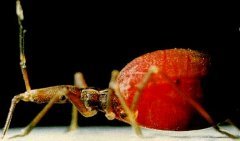 In
South and Central America cone-nosed (assassin) bugs are common
in rural areas where housing standards are low. They can grow
up to 4cm in length with a thin head and long mouth parts.
They can transmit Chagas Disease (South American Trypanosomiasis)
which is a serious and sometimes fatal illness. Like bed bugs
they live in cracks in walls and come out at night to feed. In
South and Central America cone-nosed (assassin) bugs are common
in rural areas where housing standards are low. They can grow
up to 4cm in length with a thin head and long mouth parts.
They can transmit Chagas Disease (South American Trypanosomiasis)
which is a serious and sometimes fatal illness. Like bed bugs
they live in cracks in walls and come out at night to feed.
If you
are staying where either of these bugs are suspected, move
your bed well away from the wall and if possible leave a light
on in the room all night because they prefer to feed in the
dark.
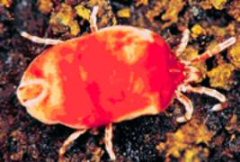 Chiggers Chiggers
Chiggers are the parasitic larvae of the harvest mite, Trombicula
alfreddugesi. The adults are harmless, but the tiny, six-legged
larval stage is parasitic on many animals, including rodents,
birds, rabbits, livestock, reptiles, toads, and humans. The
biting season is therefore limited to the late summer/early
autumn period when the larvae are active.
Chiggers occur in several parts of the world including the
southern United States and do not normally transmit disease.
However, in parts of Asia they are known to carry "scrub
typhus".
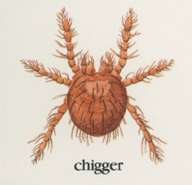 They
are normally found in brush and tall grassy areas, especially
where small rodents are abundant. Females lay eggs on the
ground in groups of up to 400, picking damp but well drained
sites. They may be particularly abundant near river banks
and under trees or bushes. They
are normally found in brush and tall grassy areas, especially
where small rodents are abundant. Females lay eggs on the
ground in groups of up to 400, picking damp but well drained
sites. They may be particularly abundant near river banks
and under trees or bushes.
The larval chigger is an active creature that moves to the
tip of grasses and fallen leaves to wait for and grab onto
a passing host. Once on its host, the chigger usually moves
about until it reaches a place where it is somewhat protected,
such as around ankles, under socks, waistline, under belts
and elastic bands of underwear etc.
Chiggers do not burrow into the skin, but they do pierce the
skin, (often around a hair follicle) and after secreting digestive
enzymes in their saliva, they suck up the liquefied host tissues.
The rash and intense itching associated with chigger bites
is an allergic reaction to their salivary secretions.
After a larva is fully fed days, it drops off the host, leaving
a red welt with a white, hard central area on the skin that
itches severely and may later develop into dermatitis. Welts,
swelling, itching, or fever will usually develop three to
six hours after exposure and may last for weeks depending
upon the sensitivity of the individual. Scratching a bite
may break the skin, resulting in secondary infections.
Insect repellents containing DEET (diethyltoluamide) are effective
in repelling chiggers. For maximum effectiveness, repellents
should be applied to shoes, socks, pant cuffs, ankles and
legs, and around the waist. They move around the body for
several hours before feeding so bathing soon after exposure
to chigger-infested areas may wash the chiggers off your body
and prevent feeding. Take a good hot bath or shower and soap
repeatedly.
Applying benzocaine cream, hydrocortisone cream or calamine
lotion may give temporary relief from the itching.
 Prevention
of Bites & Stings Prevention
of Bites & Stings
There
are basically two types of prevention of insect bites and
stings: Repellents and Avoidance.
Insect
repellents work well for biting, non-venomous insects, but
not against angry stinging insects.
Despite advertising claims, no oral products have ever been
shown to be effective insect repellents.
Avoidance
techniques for bites and stings are summarised in the tables
below:-
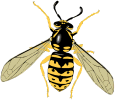 Avoiding
Stinging Insects Avoiding
Stinging Insects
-
Don't
wear perfume or scented lotions.
-
Control
odours at picnics, garbage areas, etc.
-
Avoid
brightly coloured clothing outdoors.
-
Destroy
or relocate all known hives or nests near your home.
Avoiding
Mosquitoes, Chiggers, and Ticks  
-
Cover
as much of your skin as possible with clothing, hats,
socks, etc.
-
Pay
special attention to cuff areas at ankles, wrists, and
neck.
-
Avoid
swamps (mosquitoes), dense woods, fields, and brush (ticks,
chiggers).
-
Examine
exposed skin and scalp areas for clinging ticks after
returning from hikes.
-
Use
insect repellent.
|